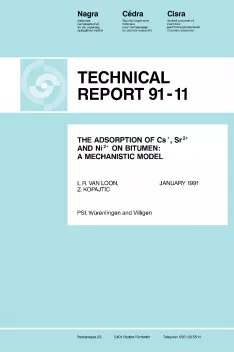
Technical Report NTB 91-11
The adsorption of Cs+, Sr2+ and Ni2+ on bitumenA mechanistic model
The adsorption of radionuclides on the waste matrix (cement, bitumen) is a positive effect and contributes to the retardation of released radionuclides migrating to the geo and biosphere. For the safety assessment studies, it is important to know whether or not radionuclides do adsorb on the waste matrix.
In the present work, the adsorption of 134Cs+, 85Sr2+ and 63Ni2+ on bitumen was studied as a function of the pH and ionic strength of the equilibrium solution. Bitumen emulsions with well defined surfaces were used.
The surface of bitumen is negatively charged due to the deprotonation of weak acid carboxyl groups at the interface. The functional group density amounts to 1.37 × 1018 groups/m2 and their deprotonation behaviour can be well described by the "Ionizable Surface Group" model.
Cs+, Sr2+ and Ni2+ adsorb on the surface by three different processes, i.e. ion exchange, outer sphere complexation and inner sphere surface complexation respectively. The adsorption depends on the pH and the ionic strength of the contact solution. Under near field conditions (cementitious environment), Cs+ and Sr2+ do not adsorb on the bitumen due to the competition with Na+, K+ and Ca2+ present in the cement pore water in contact with the bitumen.
Ni2+ adsorption can also be neglected because the formation of neutral and anionic hydroxo complexes in solution competes strongly with the adsorption reaction. Other hydrolysable radionuclides of interest are expected to behave similarly to Ni2+.
The main conclusion of the study is that the adsorption of radionuclides (cations and anions) under near field conditions is expected to be very low (Ra: 10-4 – < 10-6 cm). Consequently, this process needs not to be considered in safety assessment studies.
